Author: Nathan
Translated by: TechFlow
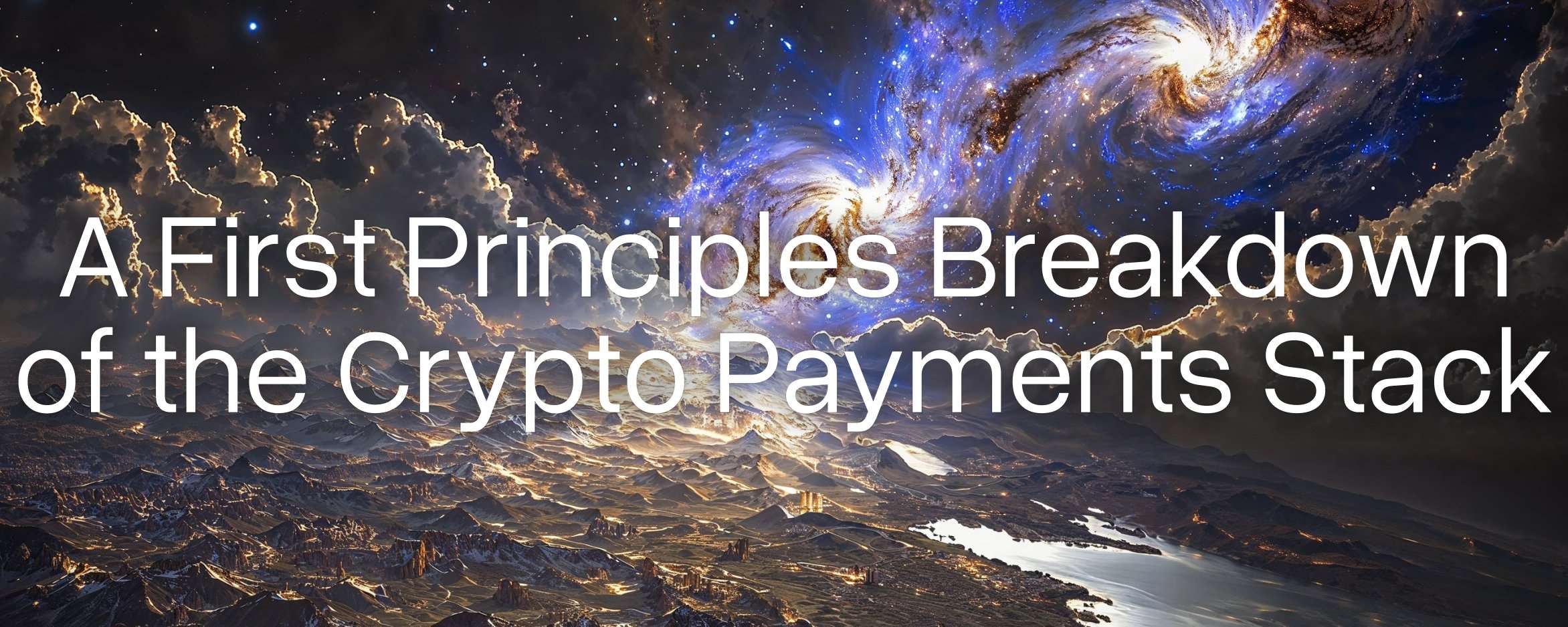
The super cycle of stablecoins has arrived.
This is not just because the total supply of stablecoins has exceeded $230 billion, Circle has filed an IPO application, or because I often mention "the super cycle has arrived". The more fundamental reason is that stablecoins are profoundly disrupting the traditional payment system, and this disruption will continue at an exponential rate.
My point is simple: stablecoins will surpass traditional payment methods because they are better, faster, and cheaper.
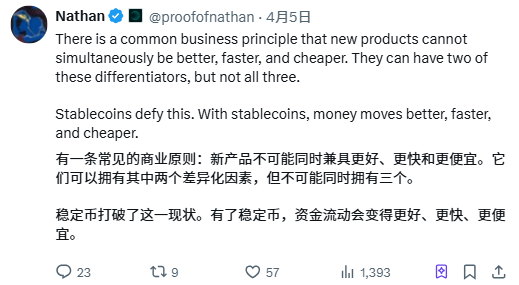
However, the term "payment" covers a wide range. Today's payment system is mainly dominated by traditional payment channels, banks, and fintech companies, each playing different roles in the Web2 payment system. Although stablecoins offer a more efficient and user-friendly alternative compared to the traditional system, the cryptocurrency payment system is gradually presenting a complexity similar to the Web2 system, thus worthy of our in-depth analysis.
Currently, hundreds of companies are developing based on or around stablecoin payment channels.
@Dberenzon compiled an excellent page that breaks down the on-chain payment ecosystem into nine different areas, which you can find below.
Related link:
https://x.com/dberenzon/status/1889717634800758858
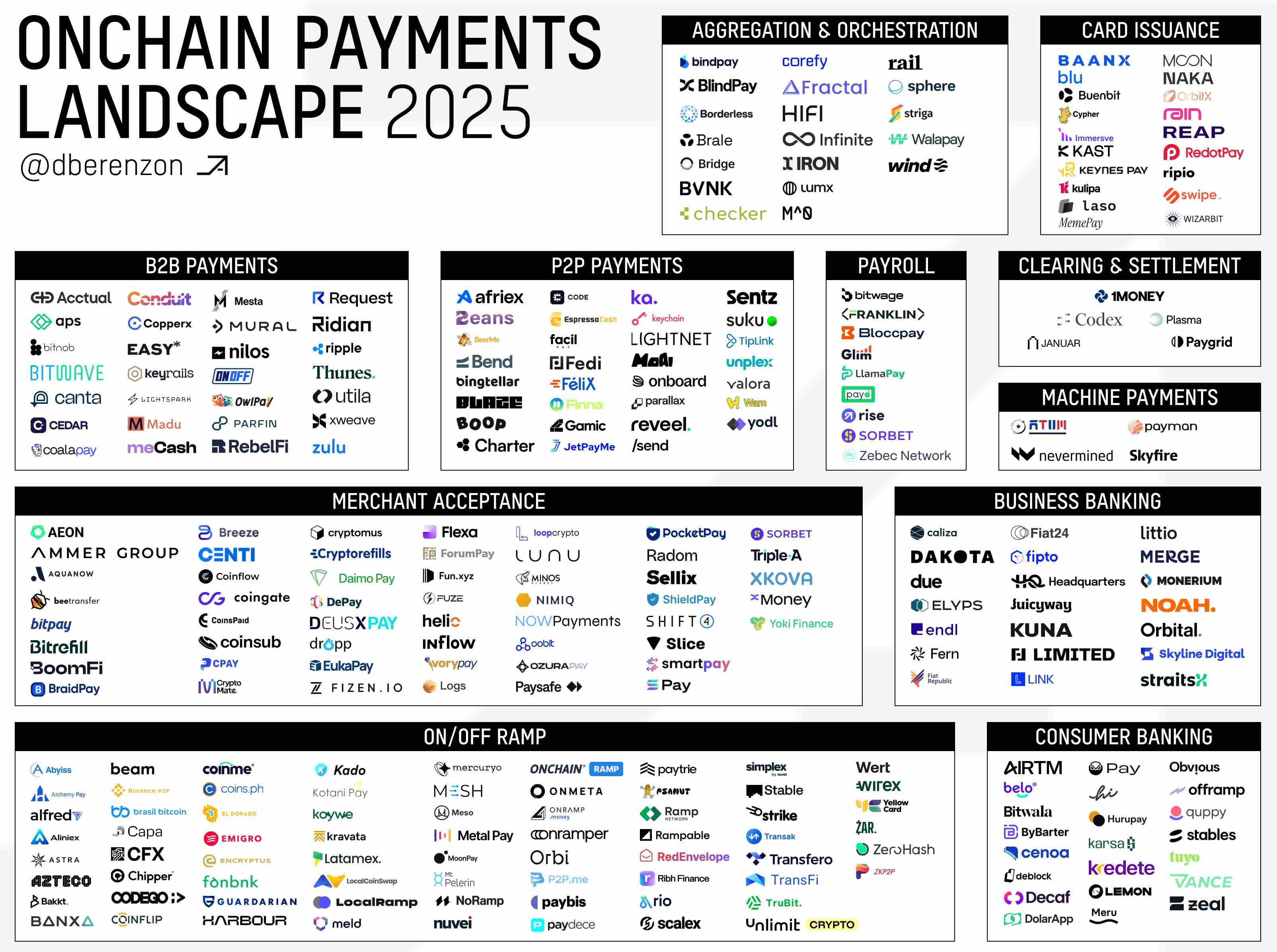
Dmitriy provided a deep and technical perspective, while other institutions, such as Pantera in their report "The Trillion Dollar Opportunity", divide the payment system into four levels from a higher perspective.
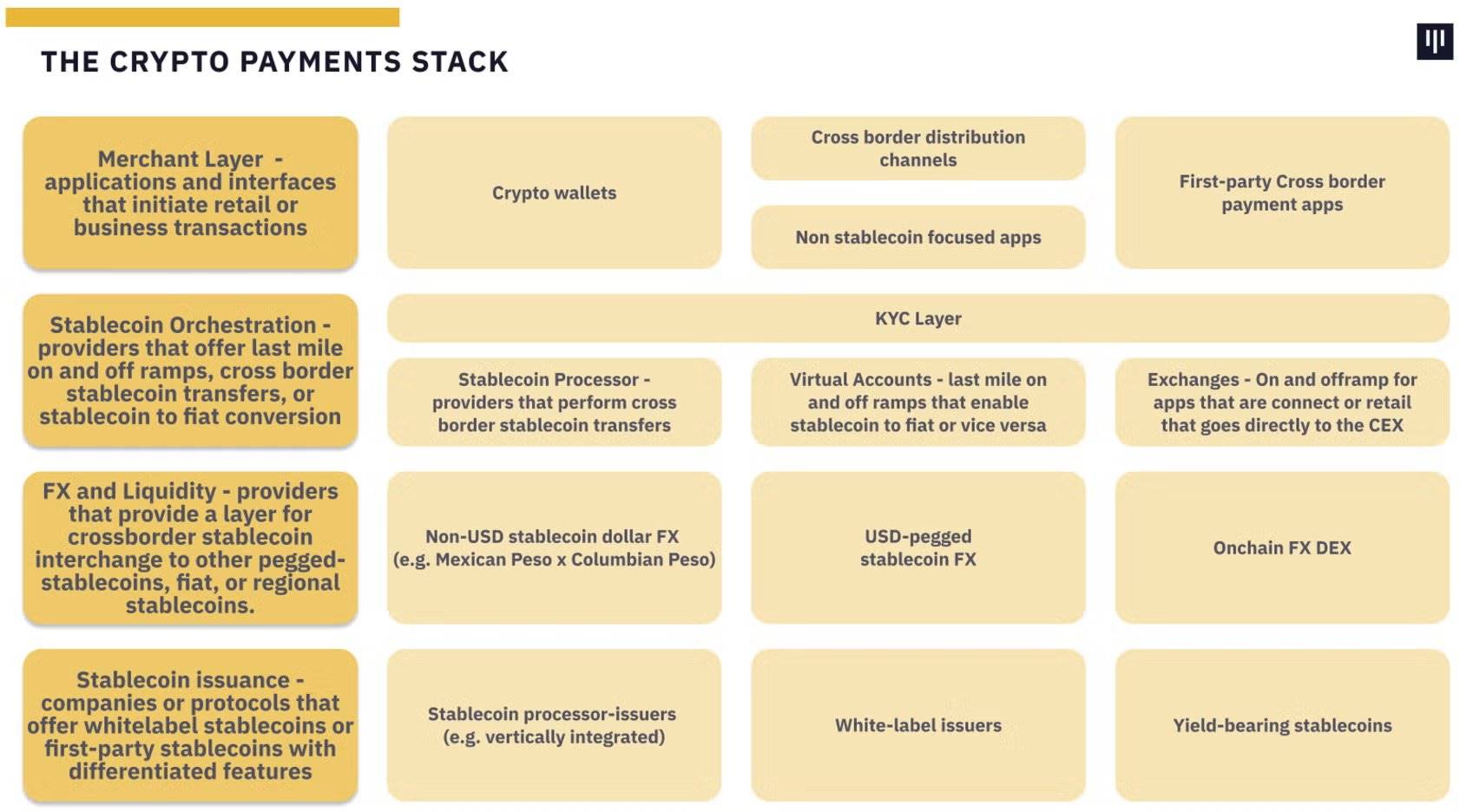
In this article, I will provide another method of breaking down the payment system from the first principles of cryptocurrency. However, the level divisions proposed by Dmitriy, Pantera, and others still provide valuable classification methods from other perspectives.
To provide some background information, I believe the payment system operates along a vertical line, with one type of user at the top and another type at the bottom. Moreover, I believe the highest goal of the payment system is to serve billions of users, so the target of this analysis is ordinary retail users who may not even know they are using cryptocurrency.
Cryptocurrency Payment System
From first principles, stablecoins are tokens on the blockchain representing a legal currency unit - most commonly the US dollar. Stablecoins come in different types, including:
Fiat-backed (such as USDT)
Crypto-backed (such as Dai)
Synthetic (such as USDe)
Among these, fiat-backed stablecoins are currently the largest type. These stablecoins are backed 1:1 by highly liquid assets, including US Treasuries, cash, and other cash equivalents, held by custodial institutions. Therefore, at the bottom layer of the payment system are traditional banks and payment systems.
As mentioned earlier, stablecoins are disrupting traditional payments because they are indeed better, faster, and cheaper. This advantage not only provides higher profit margins for fintech and payment companies but also offers a better experience for end users. Therefore, at the top of the payment system are consumers.
Currently, the structure of the payment system is as shown in the following diagram:
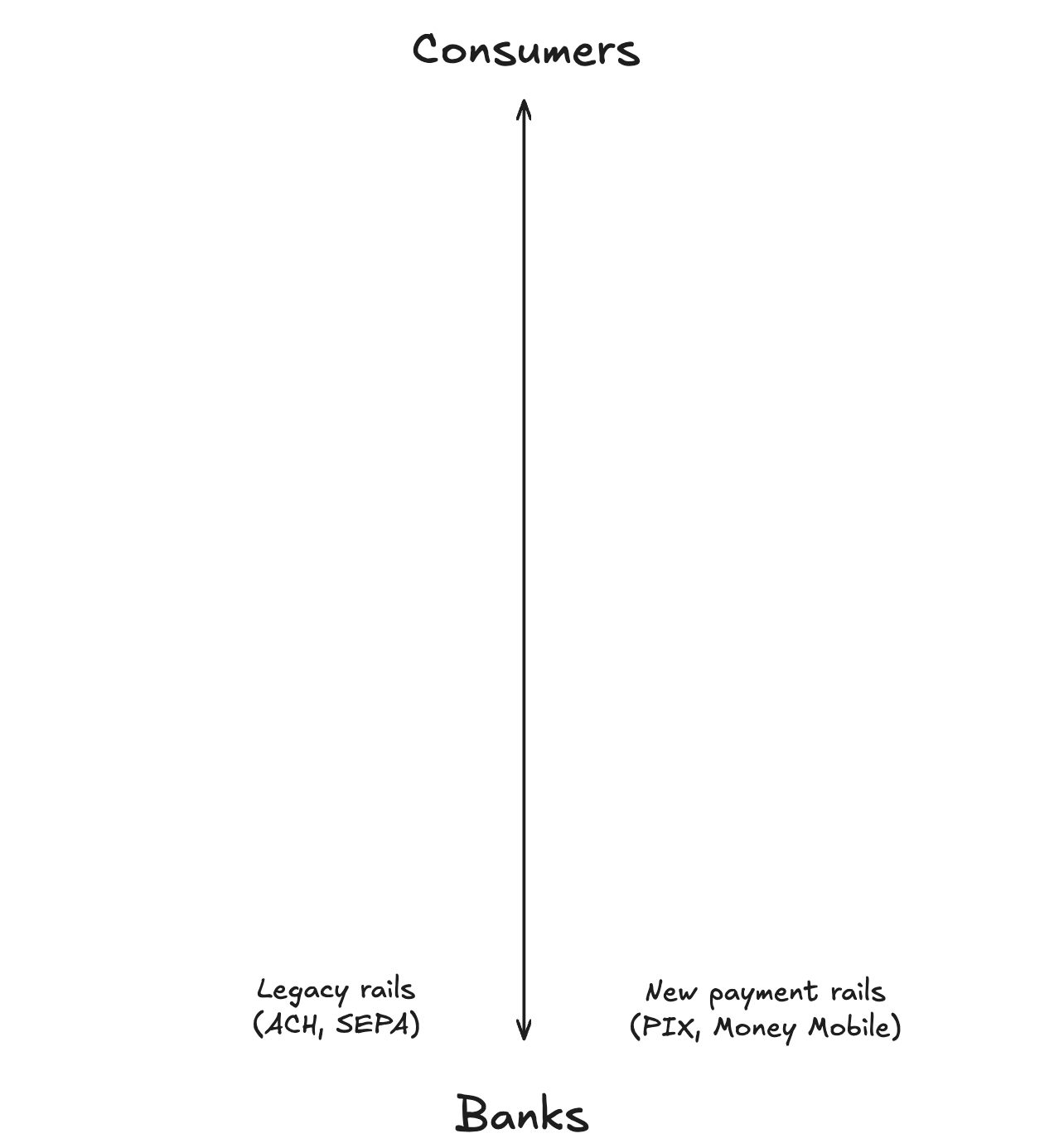
Next, let's look at the main application scenarios in the payment system. We have seen that a high-retention use case for cryptocurrency is "off-ramping". Although "on-ramping" is also popular, the ability to easily use cryptocurrency (especially stablecoins) for consumption has always been the primary demand. In our system, on/off-ramping service providers are located in the middle.
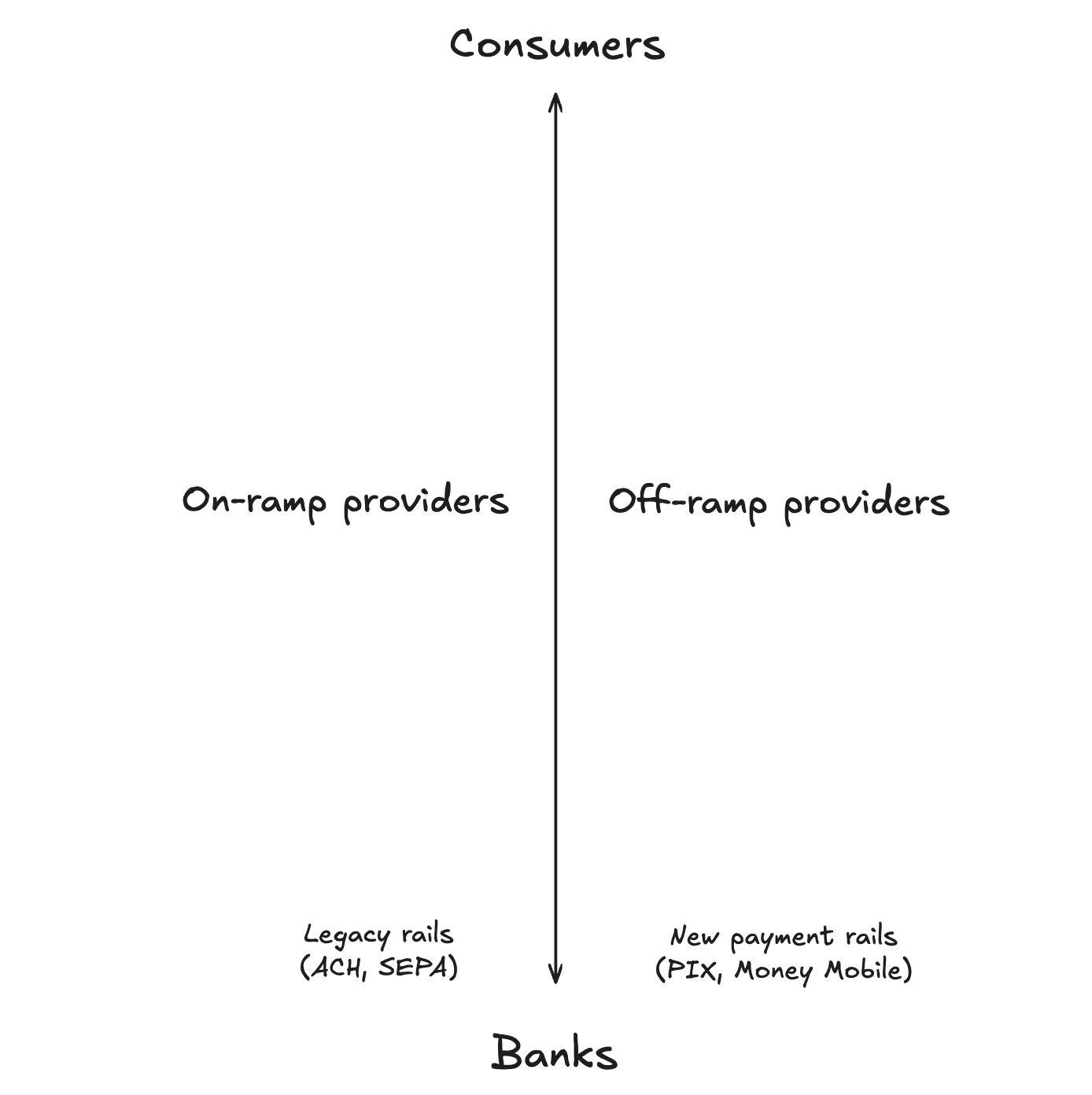
Everything above these service providers is oriented towards consumer applications or tools supporting consumers, which I call the "Consumer Service Layer". Conversely, the part from on/off-ramping services down to traditional banks is the part integrating stablecoins into the existing financial system, which I call the "Financial Integration Layer".
It is worth noting that the number of consumer service layers is significantly more than the financial integration layer. This is because building the financial integration layer requires licenses, structured operations, and compliance requirements, while the consumer service layer can leverage the services and relationships already established in the layer below. Although the consumer service layer may have other subdivisions, I focus here on the parts that play the most critical roles in the payment system based on function and dependency.
Consumer Service Layer
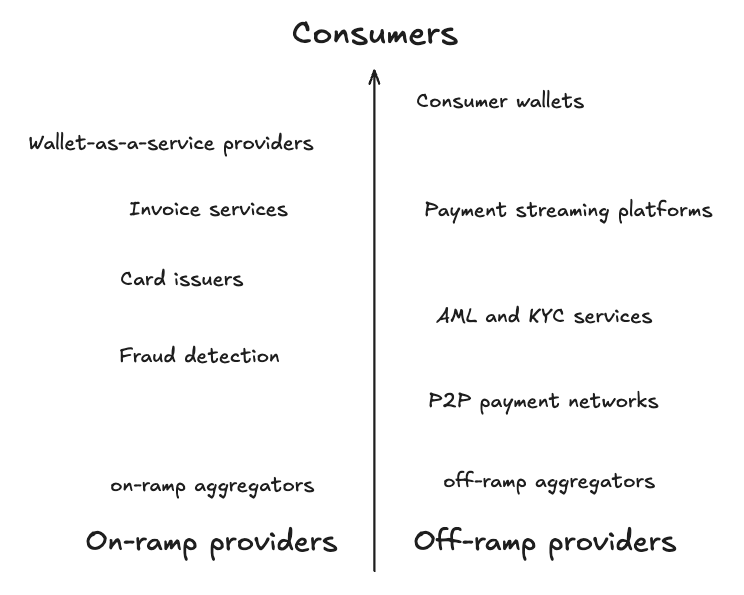
From the consumer's perspective, the journey into the cryptocurrency payment system begins with the wallet. Consumer wallets are not just storage tools, but also the entry point for users to save, spend, and earn cryptocurrency. Wallet functions include debit card payments, virtual banking services, and peer-to-peer transfers, aimed at meeting users' diverse needs. Currently, there are countless wallet choices, some with global coverage, and some designed for different regional markets.
Developing a wallet is a complex task. It requires integrating multiple services while reducing the risk of being hacked, which is why many companies choose to use "Wallet as a Service" (WaaS) providers. These providers deliver audited, proven solutions with key functions such as on/off-ramping services and card issuers pre-integrated.
To make consumer wallets truly functional, they must rely on various business-to-business stablecoin payment service providers. Core components include:
Invoice services: These platforms allow individuals to issue invoices to employers in fiat or cryptocurrency. They are responsible for generating invoices, receiving funds, and converting currencies when necessary, then depositing the corresponding currency into the wallet.
Payment flow platforms: As companies become more globalized, these platforms support seamless, periodic payments using stablecoins. This is particularly useful for employees in countries without local banking options.
Card issuers: As cash payments gradually decrease, cryptocurrency cards become crucial. By cooperating with networks like Visa or Mastercard, card issuers enable wallet providers to issue branded debit or credit cards, enhancing daily usability.
Compliance also plays a critical role in this layer. To protect consumer wallets, many platforms integrate strict "Know Your Customer" (KYC) and Anti-Money Laundering (AML) measures, as well as on-chain fraud detection services. The providers of these services play an important role in the consumer service layer, ensuring security and compliance.
Additionally, the consumer service layer includes Peer-to-Peer (P2P) payment networks. These networks operate somewhat independently of the payment system, directly connecting individuals and businesses for cryptocurrency and fiat transactions. P2P solutions provide alternatives to traditional channels and have gained significant adoption in developing regions. However, P2P payment networks are less efficient, and the settled funds are far lower than the entire payment system.
Finally, on/off-ramping aggregators are located at the bottom of the consumer service layer. They integrate multiple on/off-ramping service providers into an easy-to-integrate API, allowing wallet providers to automatically select the best solution based on a combination of speed, cost, and regional services.
Financial Integration Layer
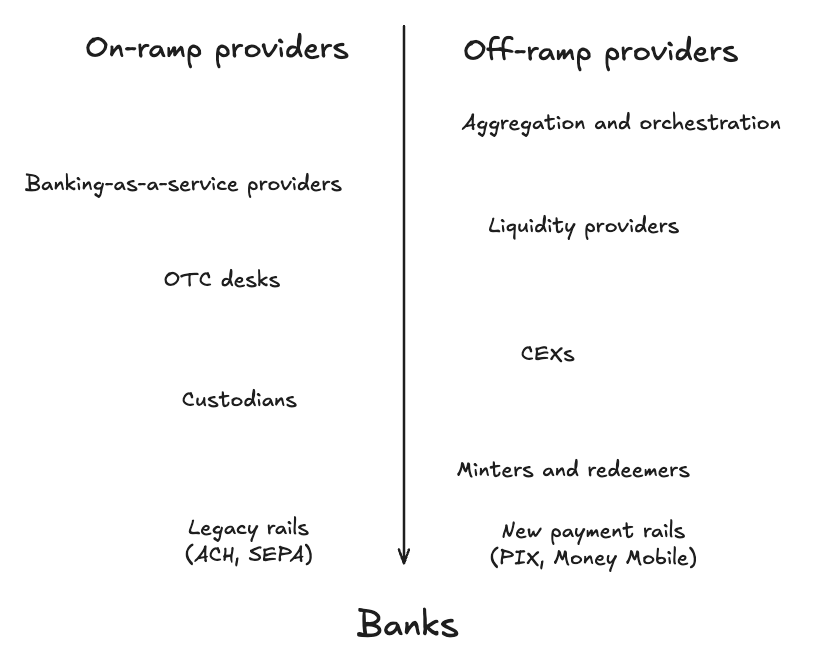
Entering the financial integration layer, we arrive at the pillars of the cryptocurrency payment system.
In many other payment systems, the part I'm about to discuss is usually referred to as "Aggregation and Coordination Layer". However, to enable aggregation and coordination, there must be underlying support. Therefore, my view is that the aggregation and coordination layer sits at the top of this category.
Below this layer are companies and services that help stablecoins and fiat currencies flow as seamlessly as possible. Here are three key layers that are typically aggregated and coordinated:
Banking as a Service (BaaS) Providers: These platforms provide modular financial infrastructure, enabling companies to integrate virtual bank accounts, cards, and payment services into their products. BaaS providers manage compliance and backend operations, allowing businesses to offer bank-like functions without holding licenses themselves.
Over-the-Counter (OTC) Counters: OTC counters handle large transactions, providing a liquidity bridge for companies lacking direct relationships with major exchanges or liquidity providers. They efficiently convert stablecoins to cash and vice versa, making settlement of large transactions more practical.
Liquidity Providers: Liquidity providers work closely with OTC counters to ensure sufficient funds are available globally to settle transactions. By abstracting the liquidity sourcing process, they eliminate many complexities in fiat-to-crypto conversions.
In many cases, no company wants to hold or manage wallets that might contain millions of dollars in stablecoins (or other crypto assets). Therefore, they rely on custodians to store liquidity in a trusted, insured manner. Custodians are located in the lower layers of the payment system, as almost all applications and services depend on them to store stablecoins as securely as possible.
Centralized Exchanges (CEX) also play a crucial role in the financial integration layer. By collaborating with liquidity providers and minting/redemption services, they settle large-scale crypto and cash transactions. CEX holds stablecoin and cash reserves, effectively facilitating transactions between parties.
Finally, at the bottom of the cryptocurrency payment system are minting and redemption services or companies. Tether operates through a limited network that can mint and redeem USDT, directly receiving cash in bank accounts or through custodians. On the other hand, Circle's Circle Mint allows qualified companies to mint and redeem USDC after "Know Your Business" (KYB) checks.
The Complete Picture
Payment systems are dynamic and highly interconnected. Each layer depends on the tools, services, and providers beneath it. Overall, the cryptocurrency payment system looks like this:
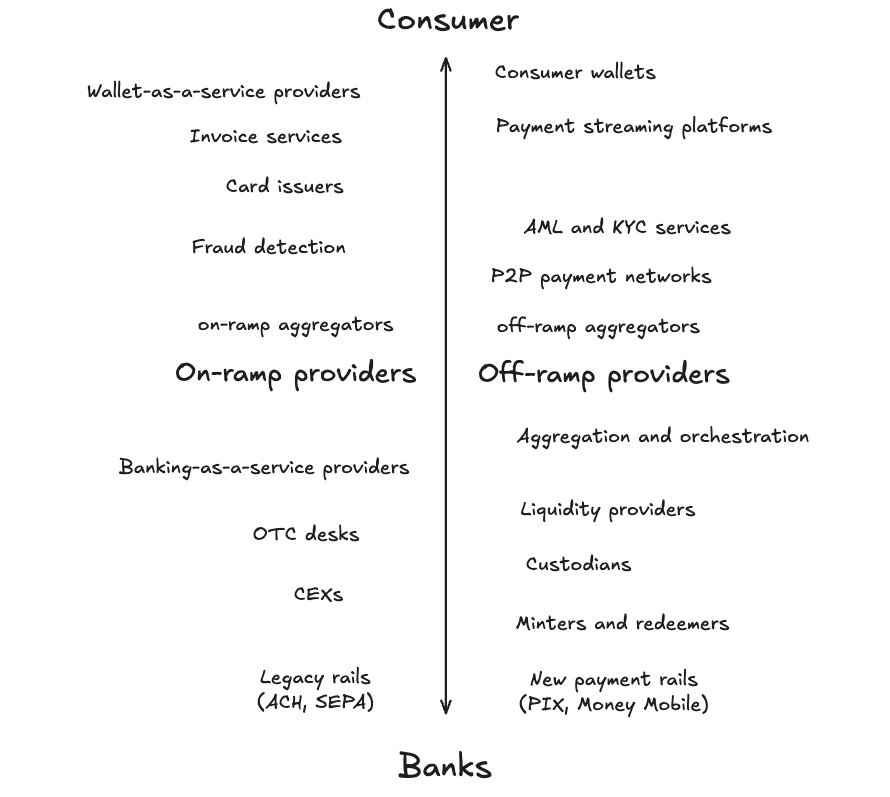
Concluding Thoughts
Stablecoin-backed payments are one of the most impactful and adoptable use cases of cryptocurrencies besides BTC as a store of value.
@PlasmaFDN as a blockchain designed specifically for stablecoin payments is well-positioned, but I anticipate almost all blockchains will eventually pivot towards stablecoins and payments. To do this, they must rethink their payment systems, as merely being EVM-compatible is no longer sufficient.
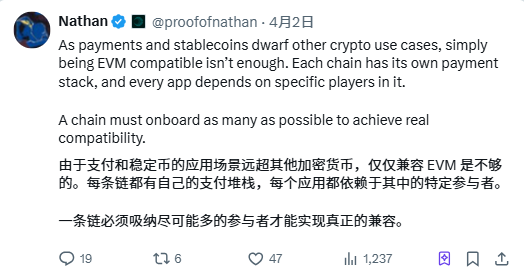
In conclusion, stablecoins indeed represent a trillion-dollar opportunity, and those playing key roles in the payment system will reap the greatest benefits.








